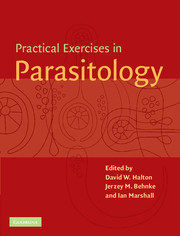Book contents
- Frontmatter
- Contents
- List of contributors
- Preface
- General advice
- 1 Observational Exercises on Parasites
- A Local wild and domestic hosts as sources of parasites
- B Laboratory maintained species
- 1.8 Protozoan parasites of the intestinal tract of the cockroach, Periplaneta americana
- 1.9 Protozoan parasites of the mouse intestinal tract
- 1.10 Rodent malaria
- 1.11 Malaria: an example of a vector transmitted parasite
- 1.12 Larval and adult Echinostoma spp. (Trematoda)
- 1.13 Schistosoma mansoni (Trematoda)
- 1.14 Hymenolepis diminuta (Cestoda)
- 1.15 Heligmosomoides polygyrus (Nematoda)
- 2 Ecology
- 3 Physiology and Biochemistry
- 4 Pathology and Immunology
- 5 Chemotherapy
- 6 Molecular Parasitology
- 7 Behaviour
- Appendix 1 Reagent index
- Appendix 2 UK suppliers
- Appendix 3 US suppliers
- Index
1.14 - Hymenolepis diminuta (Cestoda)
Published online by Cambridge University Press: 05 June 2012
- Frontmatter
- Contents
- List of contributors
- Preface
- General advice
- 1 Observational Exercises on Parasites
- A Local wild and domestic hosts as sources of parasites
- B Laboratory maintained species
- 1.8 Protozoan parasites of the intestinal tract of the cockroach, Periplaneta americana
- 1.9 Protozoan parasites of the mouse intestinal tract
- 1.10 Rodent malaria
- 1.11 Malaria: an example of a vector transmitted parasite
- 1.12 Larval and adult Echinostoma spp. (Trematoda)
- 1.13 Schistosoma mansoni (Trematoda)
- 1.14 Hymenolepis diminuta (Cestoda)
- 1.15 Heligmosomoides polygyrus (Nematoda)
- 2 Ecology
- 3 Physiology and Biochemistry
- 4 Pathology and Immunology
- 5 Chemotherapy
- 6 Molecular Parasitology
- 7 Behaviour
- Appendix 1 Reagent index
- Appendix 2 UK suppliers
- Appendix 3 US suppliers
- Index
Summary
Aims and objectives
This exercise is designed to demonstrate:
The external morphology of the adult stage of the cestode parasite, Hymenolepis diminuta.
The morphology of the metacestode stage (cysticercoid) of H. diminuta.
The distribution of tapeworms in the intestine.
Introduction
Many parasites use more than a single host species during the course of their life cycle. Often the larval stages develop in one host and the adults in another. Thus, the parasite must be transmitted from one host to the next in order to complete its development and the most common relationship between hosts exploited by parasites for transmission, particularly those living in the intestine as adults, is that involved in the predator-prey food chain. For example, some tapeworms develop as larvae in small flour beetles, Tribolium confusum, but parasitise rodents such as mice and rats as adults. Rodents are essentially grain feeders, but will consume insects also and therefore by depending on two host species, both of which live in close association with cereals and grain, the tapeworms ensure that their transmission cycle is completed successfully.
This exercise is based on the tapeworm Hymenolepis diminuta (Fig. 1.14.1), which develops successfully to the adult stage in the rat. In nature it is a parasite of wild rodents, but some isolates have been maintained in laboratory animals for many decades. Adult worms often achieve a length of over 80 cm. The worms can therefore be dissected from the rat intestine and handled with relative ease to show the outer structure of tapeworms, movement and general body organisation.
- Type
- Chapter
- Information
- Practical Exercises in Parasitology , pp. 115 - 122Publisher: Cambridge University PressPrint publication year: 2001
- 3
- Cited by



